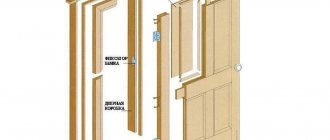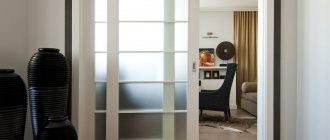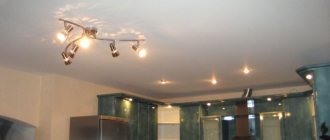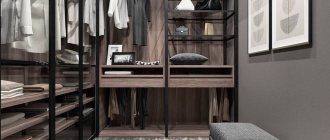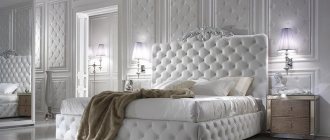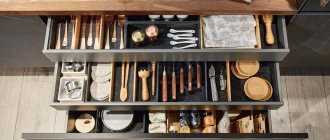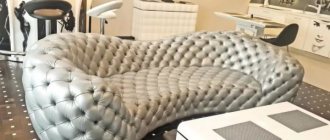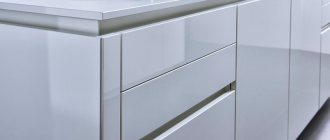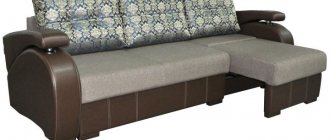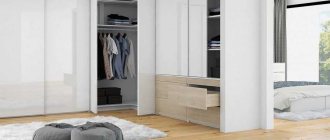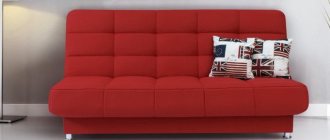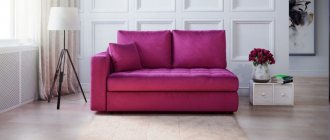General information about paneled interior doors
First, let's figure out what panel doors are. And so, panels are called inserts into the frame of the door leaf. They can be of several types, and can have a variety of shapes, be made of glass or wood, one, two or several. The variety of figured panels creates a huge range of paneled doors
. Of course, you can also create many models from straight inserts, as is the case with prefabricated doors, but panels have more different shapes, so each panel model can be called unique.
Since ancient times, paneled doors have established themselves as good-quality, solid interior doors; they were often used even as entrance doors; someone may still have a
paneled entrance door
. This indicates a high level of strength and reliability of such wooden door structures. Paneled door leaves generally have a classic look, while side doors are considered more modern. Classic doors will always be in demand in the modern interior door market, so we will consider the design features in detail.
Types of panels
Door panels differ in shape and design:
- Flat. It consists of a thin, smooth sheet without convex fragments or depressions.
- Volumetric. Considered a classic and used for most models. The insert is made in the form of a three-dimensional figure with milling.
- Typesetting. Assembled from individual lamellas. The parts are joined using the tongue-and-groove method.
According to installation, the canvas is divided into two types:
- The figurine panel is inserted into the longitudinal grooves of the frame, where it is secured with wood glue. The canvas is characterized by thick edges that turn into thinner edges.
- Floating the insert is fixed with glazing beads. The element is placed in the frame so that a small gap is formed around the perimeter. During changes in humidity and temperature, the panel “walks” freely, thereby preventing its deformation.
The ability to use thin inserts of different configurations allows you to realize the most daring design ideas.
Design features of paneled doors
Integral parts of the paneled fabric are the upright parts, cross members and, of course, panels with glazing beads. The upper and lower crossbars often differ in height; as a rule, the upper crossbar is shorter in height than the lower one. If the upper crossbar has a height of 10 to 15 cm, but the lower one can be up to 30 cm. The width of the uprights, as a rule, also ranges from 10 to 14 cm. It is believed that it is these dimensions of the component parts that give the paneled fabric an aesthetic and neat appearance. The frame of a paneled door leaf can be made of glued wooden slats, that is, have a slatted structure
, as shown in the following figure.
This design undoubtedly has high strength and good noise insulation due to the absence of voids inside the canvas. The frame of the canvas is glued together; the non-dismountable system eliminates the possibility of replacing parts of the canvas, except for the panels. If high-quality wood is used, such a canvas does not require additional layers of MDF to achieve the desired surface quality for further coating. This is often the case with painted veneer or paintwork. But such doors have a high cost compared to the next type of paneled door structures
.
The figure shows a frame-panel structure
door leaf with panel. This canvas is much lighter than the previous type, production is cheaper, aesthetics and practicality remain at a high level. Sound insulation and impact resistance here depend more not on the number of voids in the frame, but on the thickness of the paneled part. Although these qualities are of little interest to the buyer, because if you take a glazed sheet, there is no point in talking about impact resistance and sound insulation.
A framed panel door is superior in practicality to a solid wood door. When properly manufactured, an MDF frame minimizes the possibility of deformation of the canvas during use or improper storage. Let's consider the advantages and disadvantages
paneled doors.
Advantages and disadvantages
From all of the above, we can conclude that paneled doors have the following advantages , such as:
- Decorative and aesthetic appearance.
- Thanks to the thin insert, the weight of the canvas is reduced.
- The structure can be disassembled with the replacement and restoration of its elements.
- The durability of the structure is determined by the presence of an insert made of a different material. After all, a solid massif of soft rocks can dry out within a few years.
- Reducing prices by reducing the amount of material and replacing expensive elements with cheaper analogues.
The use of low-quality raw materials and non-compliance with the rules of technology during production are shortcomings that depend on the integrity of the manufacturers and are entirely on their conscience. In general, loin doors are an ideal option and can be installed in any home.
Thus, the panel is the central part of the door, which is distinguished by a number of positive features and often has an aesthetic function, as it is shaped into a variety of shapes, decorated and made from a variety of materials.
pros
— The high technical characteristics of panel doors keep their solidity high in the eyes of the buyer, although they are gradually being replaced by more modern types of interior doors. — Wide range of door leaf design options and colors. Since the production of panel doors began earlier than other designs, there is a wide variety of models. — The noise and heat insulation of panel doors is rated as above average, but they are different for each model, so average indicators are taken. — Paneled interior doors are distinguished by the variety of molded products and additional elements (capitals, caps, cornices, rosettes, squares, bases). — The likelihood of a paneled door subsiding is relatively small, because, as a rule, they are not assembled dry - the parts are glued together or glued into one frame with MDF sheets on both sides.
Rules of care
In order for a paneled door to serve for a long time and maintain its beautiful appearance, proper care is needed:
- Light scratches are covered with furniture varnish or polish.
- The deepest damage is repaired with a wax pencil or decorative putty, and the top is covered with restoration varnish.
- Veneered models are rubbed once a year with a polish containing wax.
- For cleaning, use detergents that do not contain acids or abrasives. Later, the dry surface is rubbed with polish.
- If painting is necessary, the canvas is first coated with a primer. After drying, you can apply any enamel, but not based on acetone or other brutal solvents.
Minuses
— The relatively high cost of paneled door blocks repels some potential buyers of the modern interior door market. — Due to the falling popularity of this type of door structures, the interest of manufacturers in developing new models is decreasing. — The non-separable design eliminates the need to replace parts of the canvas in case of severe damage, except for the panel. Replacing glass in a glazed panel is also accompanied by difficulties in dismantling the glued or nailed glazing bead. — If the paneled fabric has protruding glazing beads, approximately 10 mm on each side, then it is not advisable to use it for a sliding system. Such a canvas requires a large gap between the canvas and the wall to prevent the glazing beads from rubbing against the wall or the trim of the false box. This, of course, greatly reduces the tightness of the closed sliding system and reduces the aesthetics of such a design. — A paneled door can weigh from 20 to 50 kg, depending on the materials and size. It is not advisable to install doors heavier than 30 kg in plasterboard partitions; there is a possibility of microcracks appearing or the geometry of the partition being damaged.
Production materials
The most expensive ones are made from valuable wood species. They have increased strength, both due to the features of the material and due to the unusual fastening of the panels to the canvas. In addition to the usual species - oak, beech, teak, walnut, and others, paneled doors can also be made from the most exotic wood species, for example, mahogany. In some cases, exotic species are imitated by applying a special varnish.
For those who like to save money, but prefer decent natural materials, soft varieties of wood are suitable. They are quite strong to serve their owners for a long time, but not as expensive as valuable breeds. Structures made from soft wood are suitable for rooms where traffic is not so high, or where doors are used only during a certain period, for example in a country house. Despite their affordable price, they are treated with special anti-corrosion and anti-fungal compounds and, at the request of clients, treated with varnish with pigments, which allows you to give the wood the desired color. Even after such manipulations, the canvas looks natural and beautiful.
Combined doors involve a combination of cheap materials and good finishing. The first point allows you to create a door that is attractive to the buyer, and the second point allows you to use it in different design solutions. Perhaps this option will not last for several 10 years, but it will be a good addition to the interior in terms of strict economy.
How to choose panel doors
Like other types of doors, paneled doors have one of a number of coatings: enamel, veneer, eco-veneer, PVC. This is the first criterion by which the choice of interior doors
for a residential or commercial premises is made. It is believed that when selecting options, it is necessary to take into account the purpose of the door, that is, where the door will be installed. Of course, a paneled door block can be installed anywhere, it all depends on the coating, because they are even used as entrance doors, and here are the most stringent conditions for a wooden door. There is active use, and sharp temperature differences on different sides, condensation can form, direct sunlight, etc.
Among the general recommendations for choosing an interior door, the main ones can be highlighted. So, first of all you need to determine the build quality
parts and quality of decorative coating applied to the door leaf and components. If there are figured millings, then it would be a good idea to carefully inspect their quality: there should be no roughness, burrs, chips or knots. Of course, wood is not always perfect, but it can always be corrected; for example, minor defects can be corrected with wood putty.
It is important that there are no gaps between the pillar parts and the cross members of the door leaf; they not only degrade the aesthetics of the door, but also reduce its strength. After all, no matter how dry the tree is, over the years, wooden panel doors
have the property of slight subsidence precisely due to the above-mentioned gaps. Modern interior doors mainly have a frame-panel assembly; it eliminates the possibility of subsidence due to the MDF layer glued to the wood. Therefore, you need to pay attention to the quality of installation of the paneled part into the door leaf. Here, too, unnecessary gaps, nails or holes from studs on glazing beads may be observed. In the case of veneered doors, due to the curly shape of the beads, it is difficult to apply a high-quality layer of veneer on them, so some manufacturers of interior doors simply coat their beads with a paint coating.
If the door leaf has a glass panel
, then it must be installed in a rubber seal, or, as an alternative, there must be a seal made of silicone sealant. It is very unpleasant to use interior doors with rattling glass. If the sealant is easy to identify in the fabric, then the sealant should not protrude beyond the bead. Information about its presence can only be obtained from the manufacturer of the specific door taken.
Paneled doors in the interior (28 photos)
Individual design
What a panel is is clear - it is an insert-type canvas attached to a wood base. Now we need to figure out the door block of the paneled product, and how all the parts are assembled into a single system. The basis is the frame. For its production, beams from solid wood or glued blanks that have undergone painstaking selection and drying are used. The frame consists of two vertical posts connected by horizontal crossbars - drawers. Grooves for the panel are cut on the inside.
The four-part frame itself is shaky. For reinforcement, additional jumpers are used to provide spatial rigidity. The system is resistant to distortions, bends and deformation. Even for the most ordinary paneled door, the base consists of at least 5 parts : 2 vertical posts, 2 horizontal crossbars and 1 lintel - centerpiece.
The base is connected with dowels or the tenon method. Thanks to this docking, the system does not warp due to temperature changes.
There may be several jumpers in a product, and the elements are placed not only horizontally, but also vertically. As a result, additional cells for the panel appear. For example, a three-panel door has two lintels. If they are further divided by a vertical element, you get 6 cells. Such a system is called six-panel.
The door panel plays a decorative role and cannot withstand huge loads. Elements are assigned rectangular, curvilinear and convex shapes. The more difficult they are, the more expensive the product.
Main types of panels
Modern panels are very diverse due to the many faces of design solutions. Shape, size, relief, painting, and much more become ideal tools for decoration. Thus, all paneled doors are divided into three main groups:
- Doors with panels made of valuable types of wood - oak, teak, walnut and others. In this case, tongue-and-groove fasteners are used, due to which the canvas as a whole receives greater strength.
- With panels made of soft wood (birch, pine and others)
- With combined panels made of chipboard, fiberboard and plywood. In production they are laminated and covered with veneer. These doors are the cheapest, which makes them the most popular on the market. These also include doors using glass inserts.
Feedback
Leave a request via feedback and receive an additional 3% discount
Content
Many people have probably heard the expression paneled doors, but not everyone can say what it is. In fact, this type of door leaf is one of the most common. What is the essence of such a design and what features does it have?
